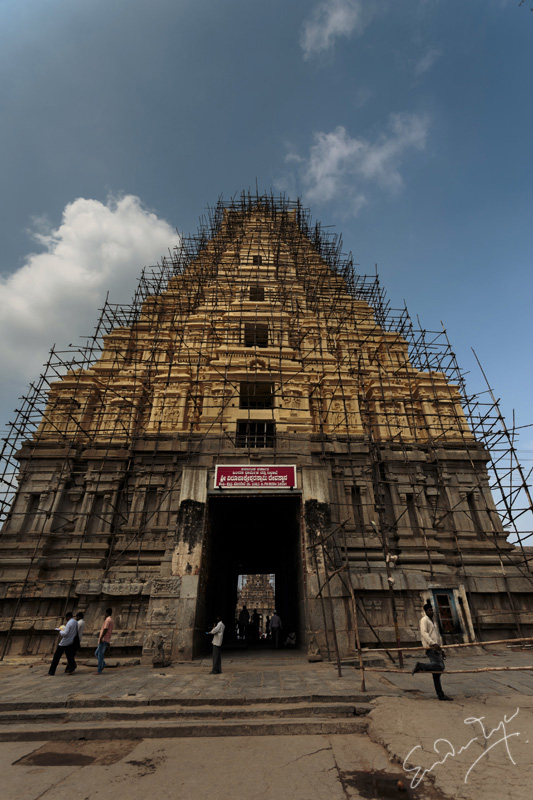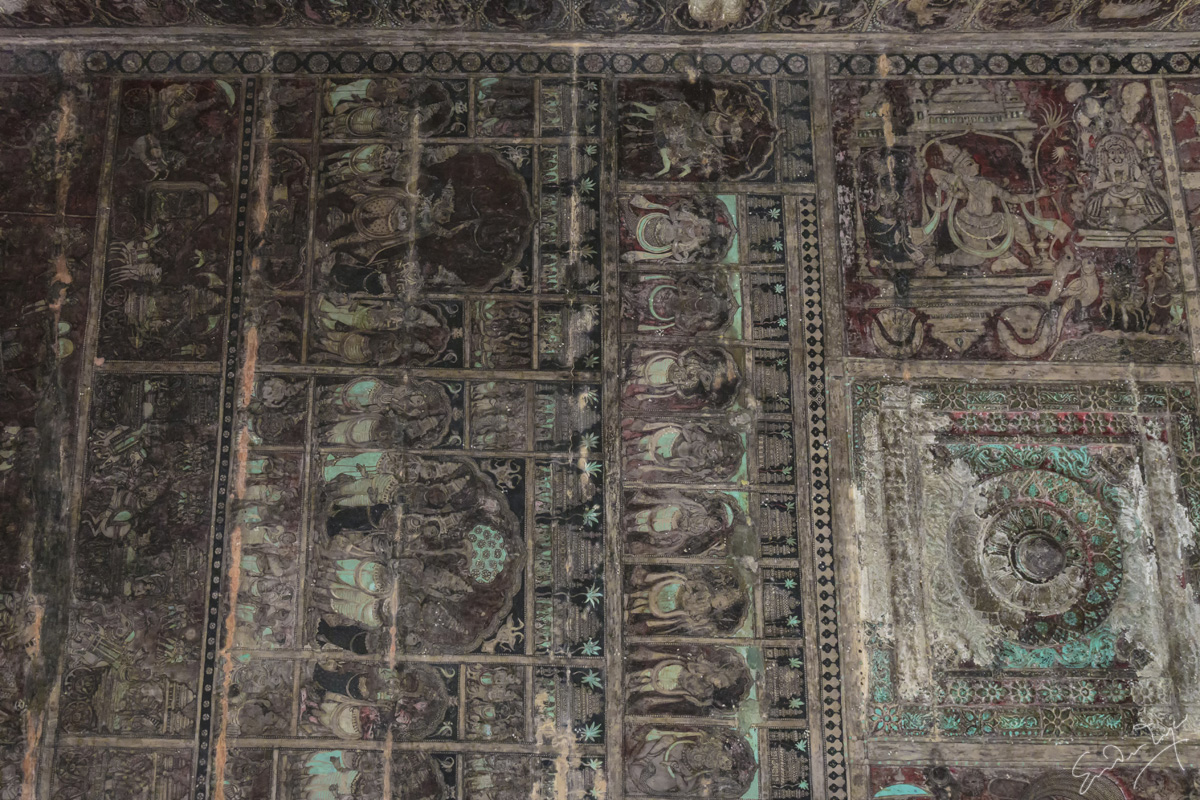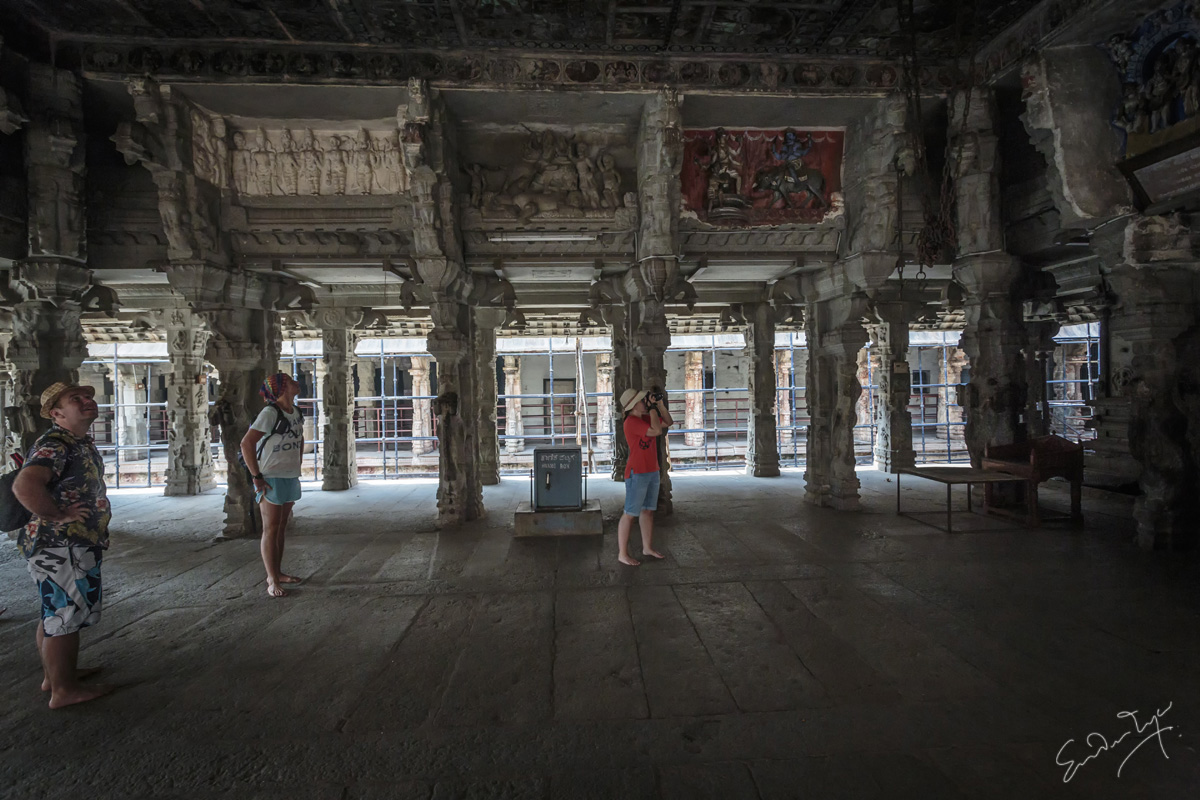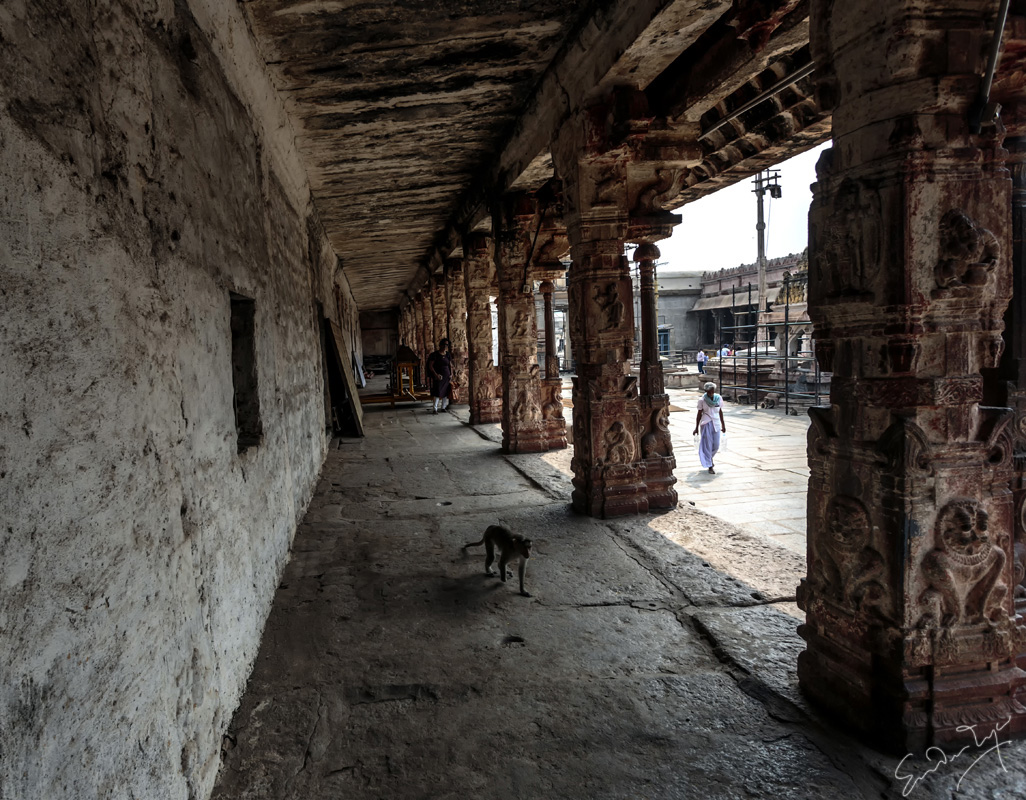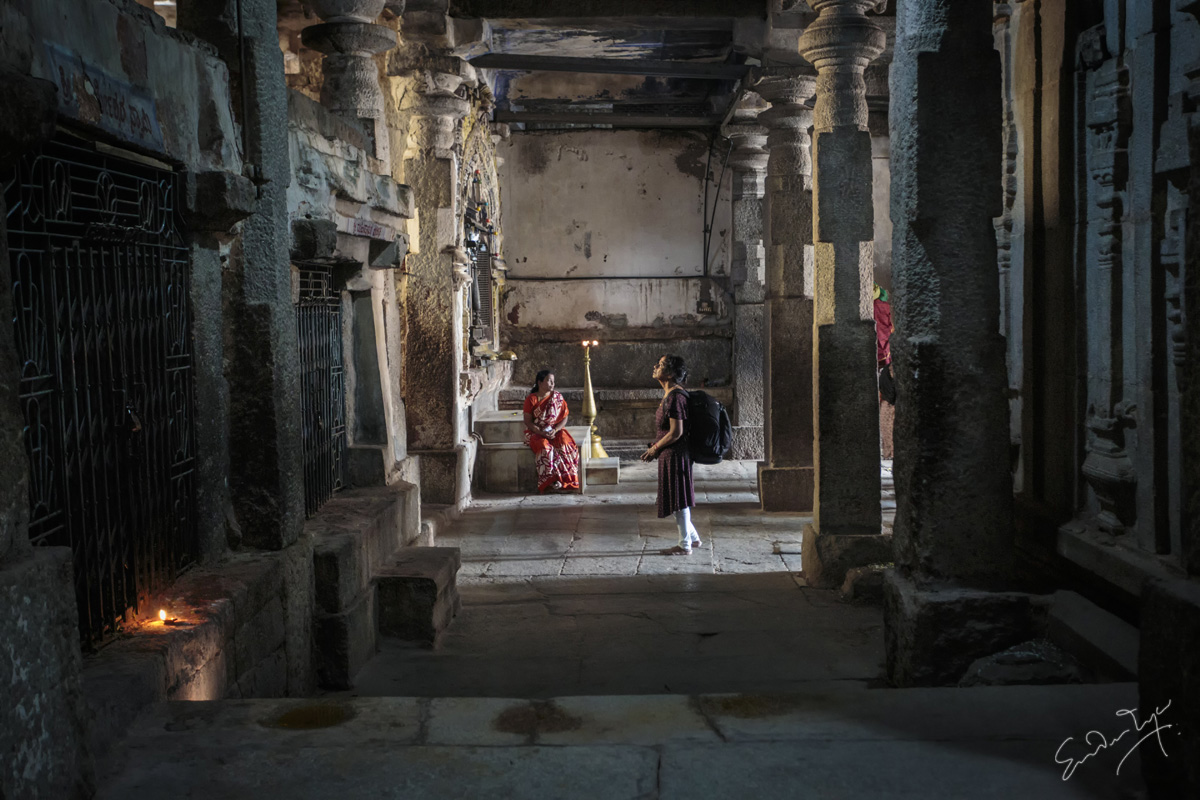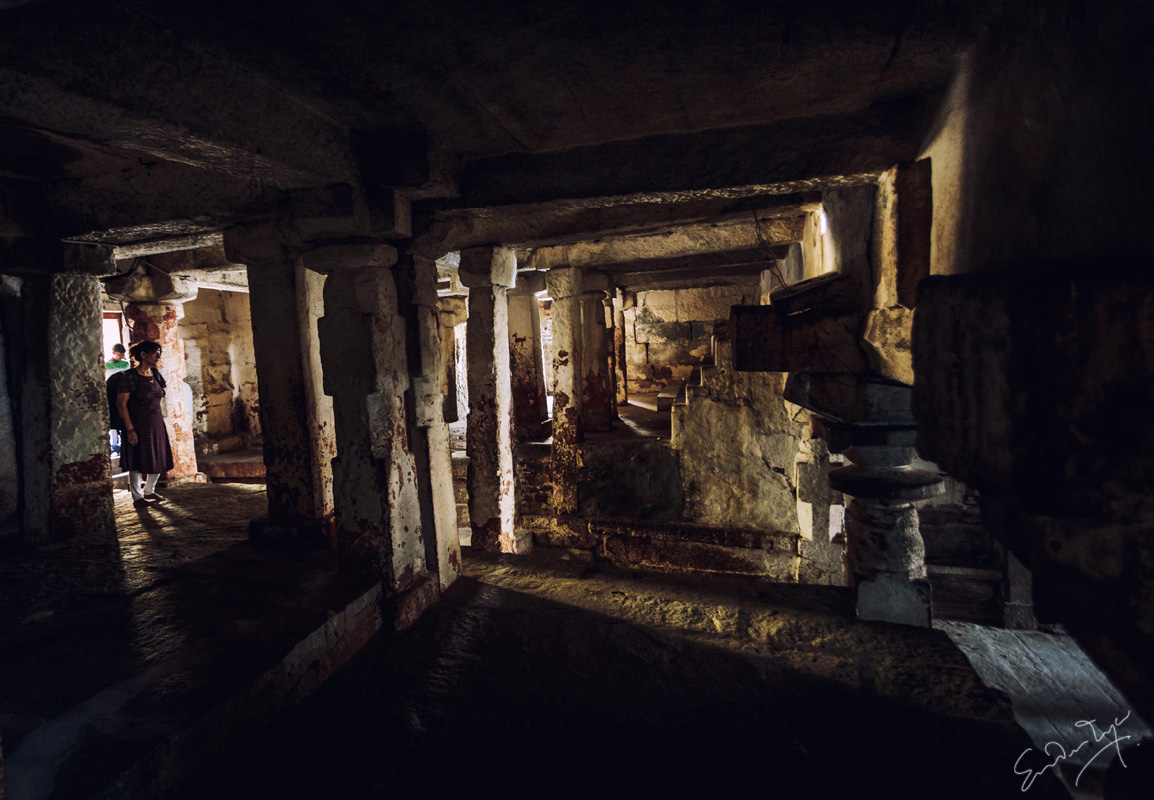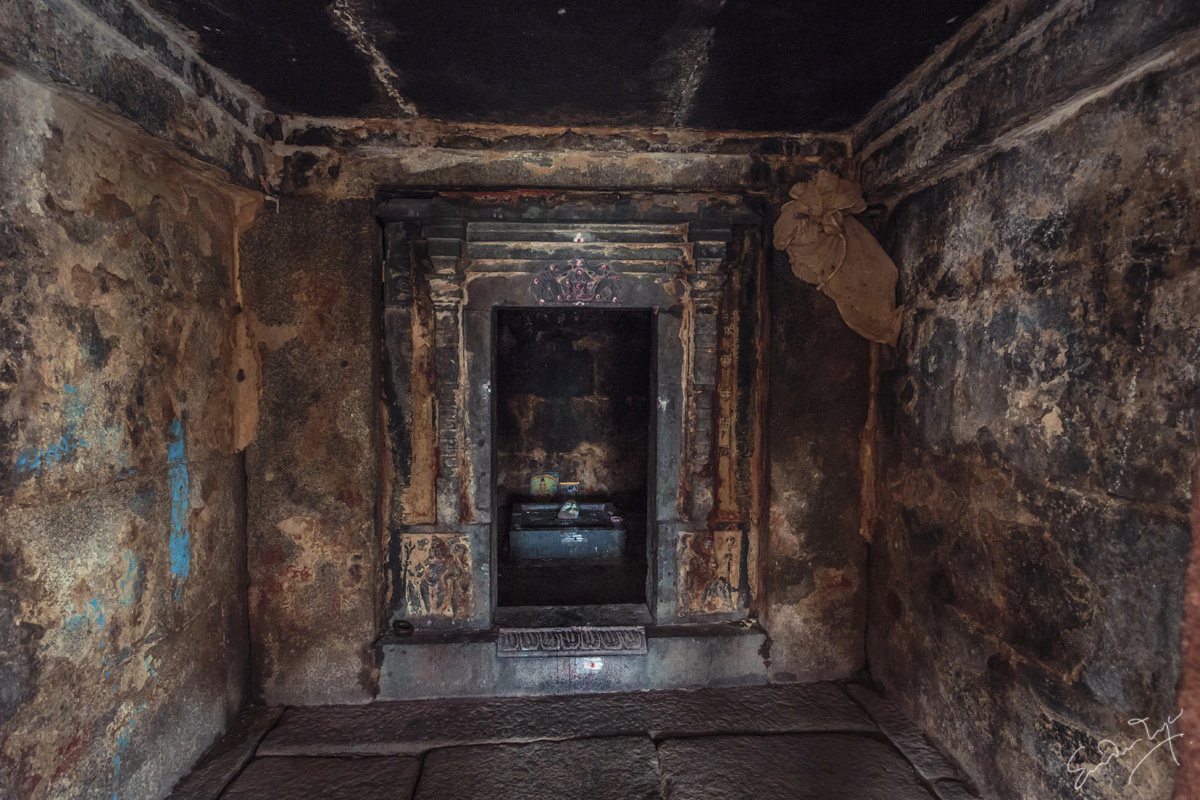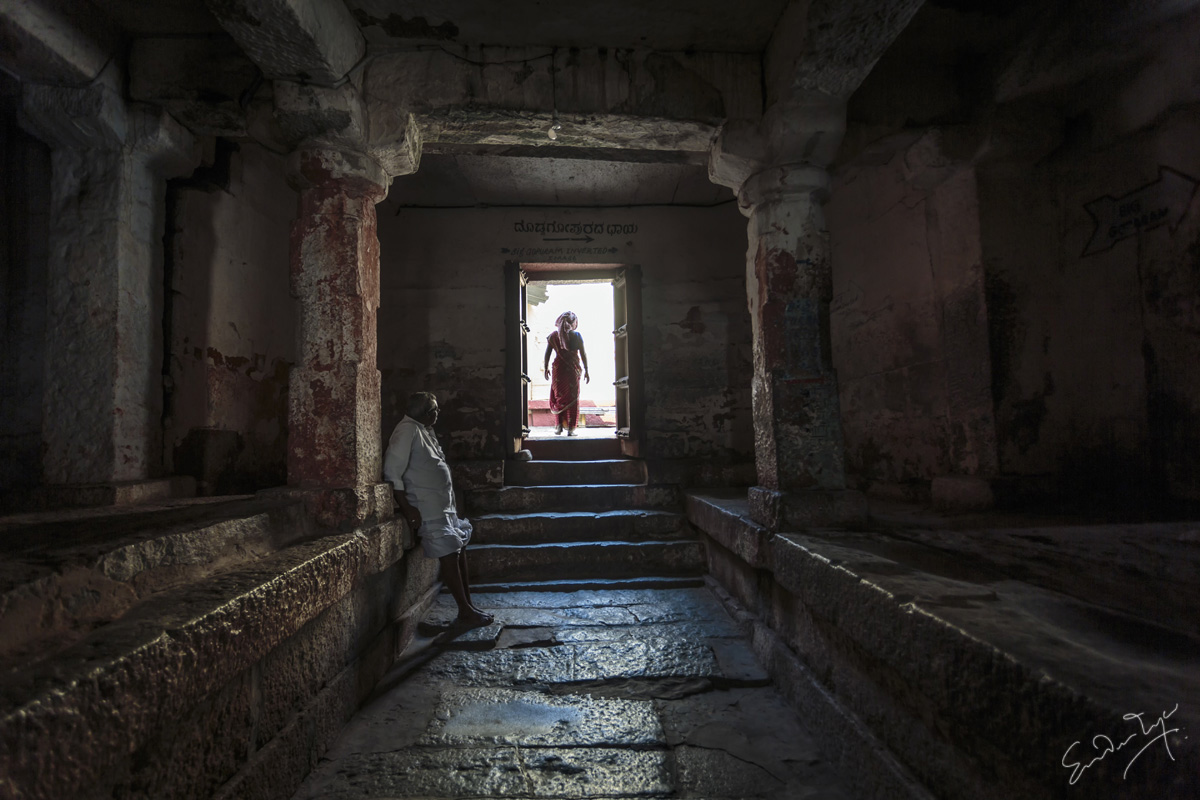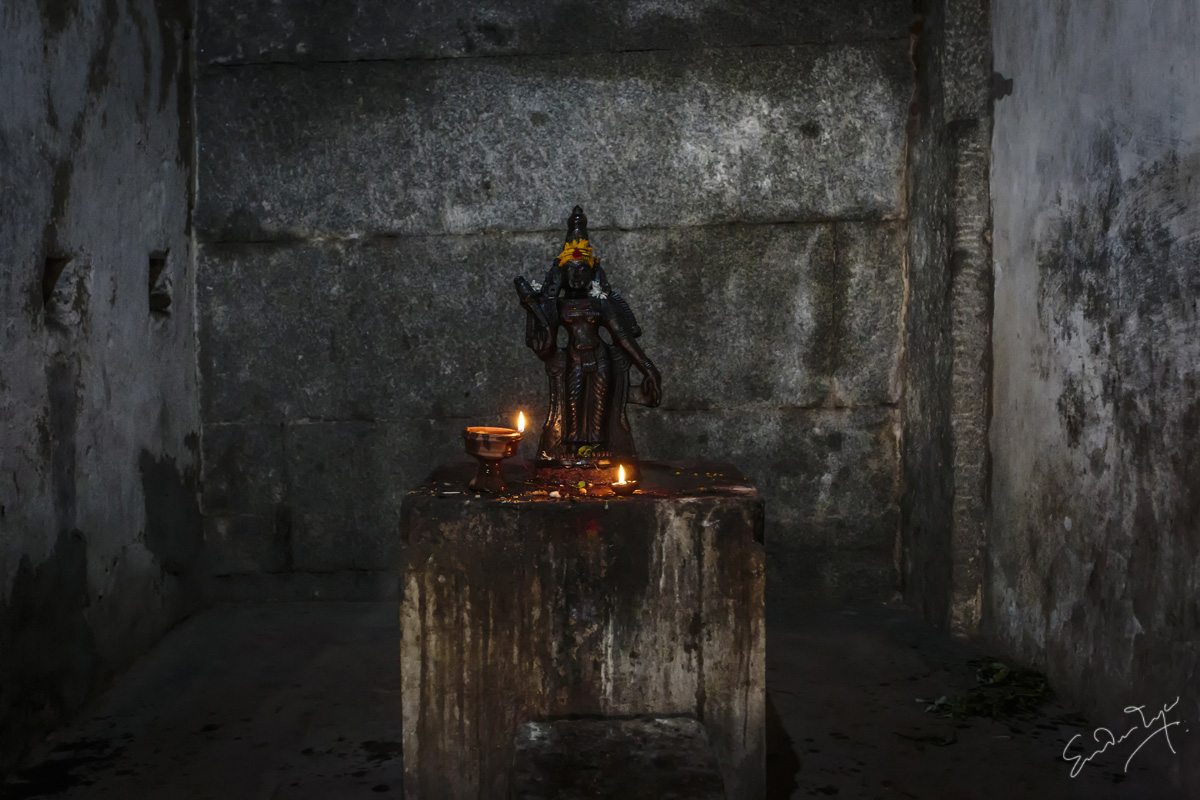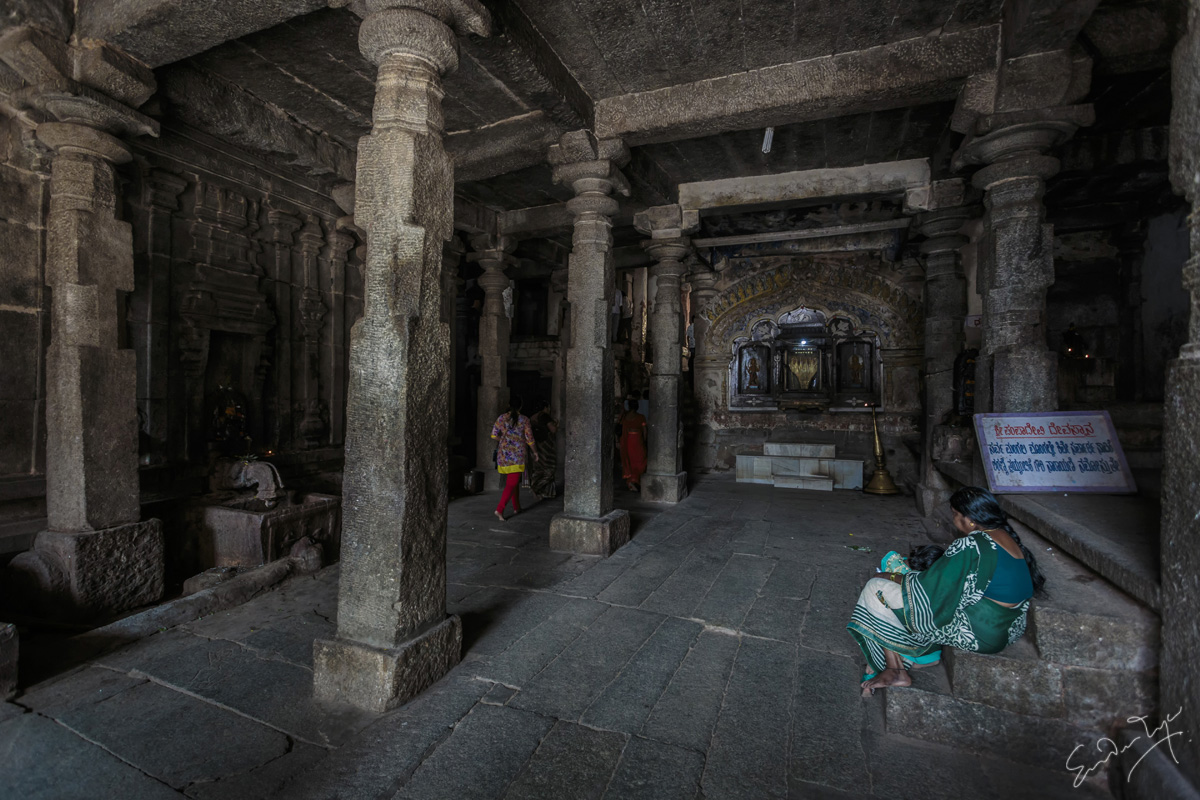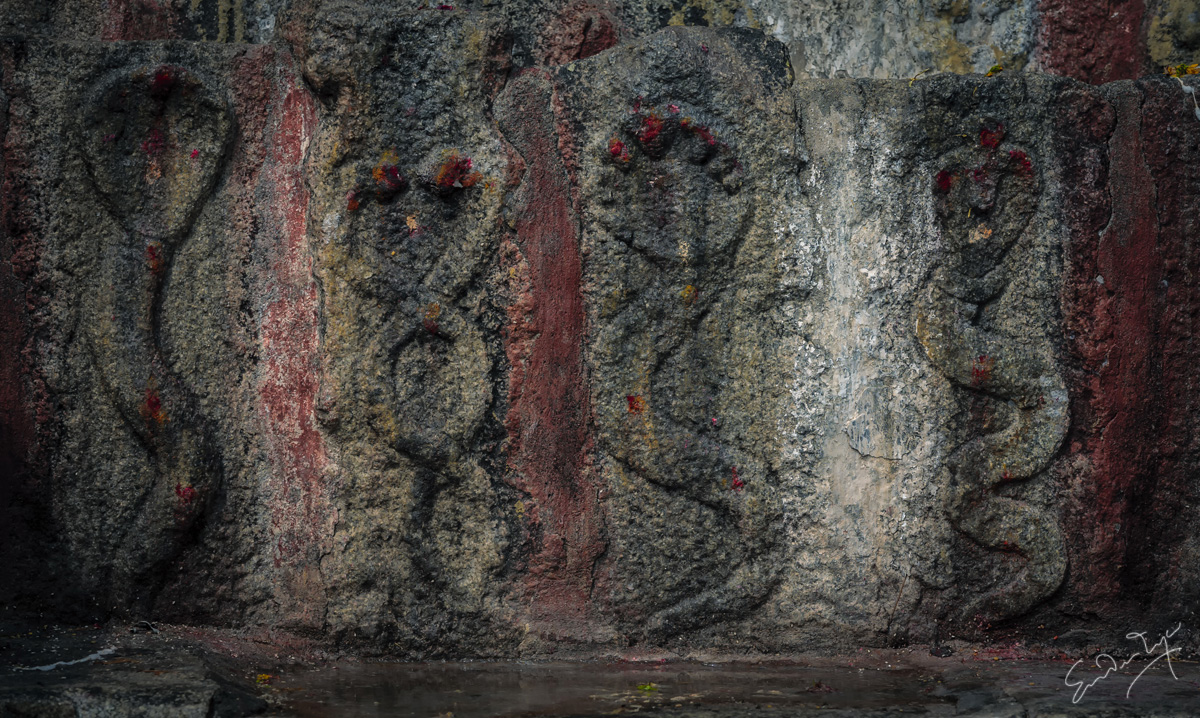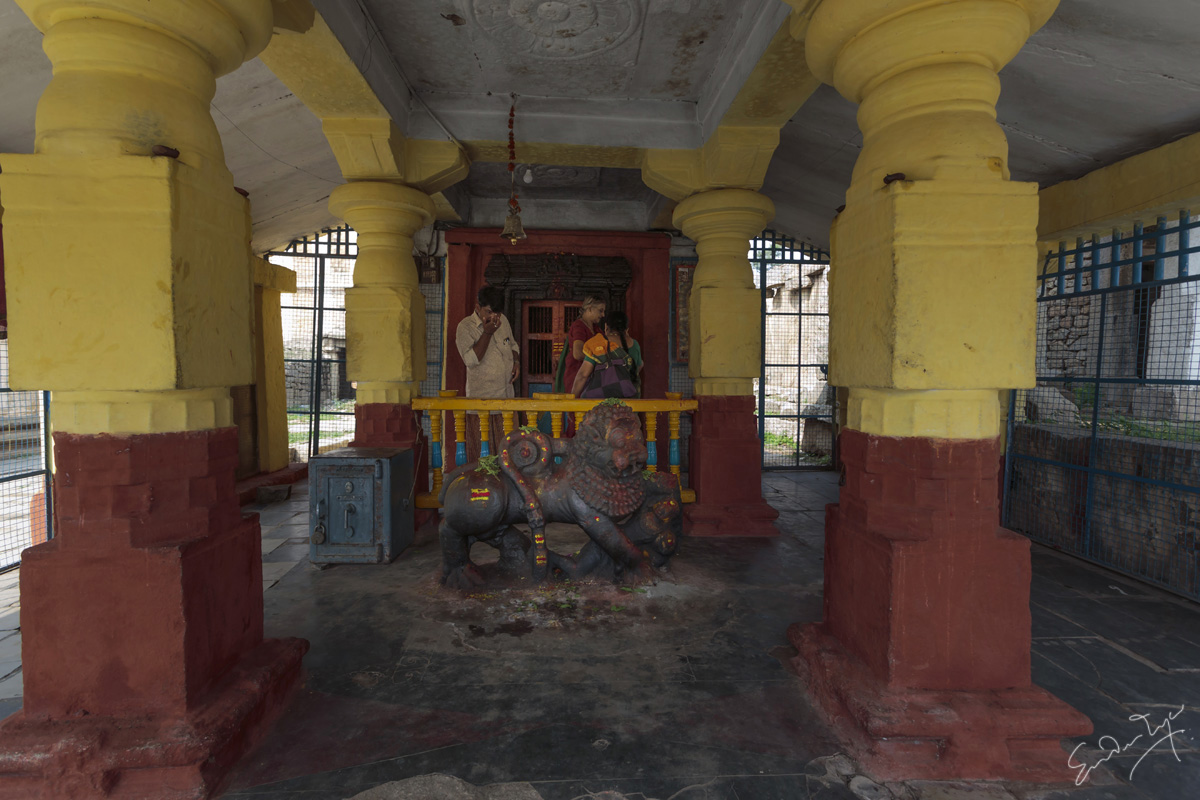.
As our vehicle entered Kalinjar fort from it's Parmala gate, on the way we could see two or three buildings, structure of a gate in another direction and scattered jungles of thorny bushes.
Parmala gate --- A view from outside
Picture by Sunder Iyer.
This damaged sculpted piece on platform, outside the Parmala gate ---Veraha, near Parmala gate. Picture by Sunder Iyer.
Running on well laid road driver ultimately stopped the vehicle at a far end on the western side of fort and told us that from that point we have to walk to reach the Neelkanth temple. Sitting in U.P. tourism guest house at Chitrakoot, our programme to visit Kalinjar fort was made on the spur of the moment. We did not have much time in hand to do a bit of research on the place before visiting it. Hence we relied on the driver, who was a local boy. we literally have no idea what to expect and believe me this ignorance turned out to be a boon. our joy and amazement on what we found was enhanced manifold as we went there without any preformed expectations, though we missed visiting the museum in the fort premises due to not being aware of it. Any way Neel kanth temple is worth visiting for it's sake only.
It was Somwati Amavsya day during Chaitra Navratri hence many pilgrims, local people thronged the premises. It is considered to be very auspicious to visit this temple on Amavsya day. I really wish to visit the temple one more time preferably on a day when lesser number of people are there. I feel the rocks, the images engraved on rocks and the entire ambience will make me harmonise with the soul of the place more deeply when silence reigns all around.
A view of temple premises from a height. Ganesha, carved on wall, the fortification wall, the big temple compound. Picture by Sunder Iyer.
Neelkanth temple is located on the western slope of Kalinjar fort. The main shrine is in a big bowl like deep valley. The shrine is in a natural somewhat octagonal cave. To reach this we have to descent down many steps. On one side of the stairs is the fortification wall and on other are rocky hills. These rocks have many small enclosures having different deities and other spiritual, mythological images. All around the rocks have beautifully carved images. It is like an open air art gallery. Go on walking up and down on the rocks and you are sure to find amazingly embellished images almost every where.
Picture by Sunder Iyer. Vishnu patta
Panel over a cave on the side of steps. Picture by Sunder Iyer
Images of Ram, Sita, Laxman, Picture by Sunder Iyer
Mahasadashiva, saivacharya and devotees. Picture by Sunder Iyer
Picture by sunder Iyer
Navgrah panel. Picture by Sunder Iyer.
Mukhalingas, Picture by Sunder Iyer
In front of the sanctum sanctorum stands the remains of a big mandap. Presently this mandap has a raised octagonal platform. Sixteen pillars run along its periphery . This mandap is open to sky. around the sixteen pillars runs an octagonal gallery, which is supported by pilasters forming outer wall of mandap. All the pillars, pilasters are richly decorated with beautiful designs and images of ratikas. May be earlier this entire octagonal mandap was covered with a roof but presently it's open. The pillars are placed at the angles of octagon and they support the architraves forming an octagon. A vedika is there at the center of the platform. On that particular day many people were conducting hawans there. The scared fire leapt and danced in the kund. Smoke rising from vedika swirled and twirled to vanish ultimately in the air above. It was as if carrying the prayers of devotees to heaven. Fragrance emanating from various offerings to the sacred fire filled the air. Chants of shlokas and prayers echoed all around. Some were busy in rituals while others sat silently,eyes closed, lost in another world/inner world. Overhead blue sky peered down showering it's grace on one and all.
The octagonal mandap. Picture by Sunder Iyer
The cave housing Lord Neelkantha is entered through a door cut into original cave. The facade of cave is richly carved having ornamental images of dancing girls, musicians and other deities. Neelkantha is in the form of Mukhlinga. The special feature of this image of neelkantha is that it's kanth i.e. neck portion is always wet. From somewhere in between the rocks, water continuously trickle down to keep the neck wet permanently. And perhaps this has imparted a bluish tint to the this portion of idol, as if justifying the name neelkantha. To the left of this Neelkantha mukhalinga is another mukhalinga which is popularly known as Kartikeya.
Santum sanctoram, neelkanth bhagwan .Picture by Sunder Iyer
At the roof level of the cave housing neelkantha is a water reservoir known as swargrohna. The water is covered with rock supported by five solid pillars cut out of rock. It has a narrow opening on western side. we can go down to reach water. there are steps cut on two sides to reach water.
Swargarohan, water reservoir. Picture by Sunder Iyer
.
I have seen the angels coming down from night sky and enter those images on the rocks-- the seers, the devotees, Gods and Goddesses all. I understand these are not just the pieces of art but infused with faith and devotion. Picture by sunder Iyer
On the sacred threshold I found myself, experienced the joy of being one with oneself. Picture by Sunder Iyer
The holy scented smoke calls me to rise above the earth, to join the world beyond, up there, to new heights, finding liberation.....Picture by Sunder Iyer
All pictures @sunder Iyer
Location -- Kalinjar, Banda, Uttar Pradesh. About 80 km from Chitrakoot and 130 from Khajuraho, around 60 from Banda.
Height-- 244 meters above plain on Vindhya Ranges
Vehicles go inside fort but for reaching sanctum of Neelkanth temple one has to walk down steps. steps are in good condition. Better to leave place before it is dark.
As our vehicle entered Kalinjar fort from it's Parmala gate, on the way we could see two or three buildings, structure of a gate in another direction and scattered jungles of thorny bushes.
Parmala gate --- A view from outside
Picture by Sunder Iyer.
This damaged sculpted piece on platform, outside the Parmala gate ---Veraha, near Parmala gate. Picture by Sunder Iyer.
Running on well laid road driver ultimately stopped the vehicle at a far end on the western side of fort and told us that from that point we have to walk to reach the Neelkanth temple. Sitting in U.P. tourism guest house at Chitrakoot, our programme to visit Kalinjar fort was made on the spur of the moment. We did not have much time in hand to do a bit of research on the place before visiting it. Hence we relied on the driver, who was a local boy. we literally have no idea what to expect and believe me this ignorance turned out to be a boon. our joy and amazement on what we found was enhanced manifold as we went there without any preformed expectations, though we missed visiting the museum in the fort premises due to not being aware of it. Any way Neel kanth temple is worth visiting for it's sake only.
It was Somwati Amavsya day during Chaitra Navratri hence many pilgrims, local people thronged the premises. It is considered to be very auspicious to visit this temple on Amavsya day. I really wish to visit the temple one more time preferably on a day when lesser number of people are there. I feel the rocks, the images engraved on rocks and the entire ambience will make me harmonise with the soul of the place more deeply when silence reigns all around.
A view of temple premises from a height. Ganesha, carved on wall, the fortification wall, the big temple compound. Picture by Sunder Iyer.
Neelkanth temple is located on the western slope of Kalinjar fort. The main shrine is in a big bowl like deep valley. The shrine is in a natural somewhat octagonal cave. To reach this we have to descent down many steps. On one side of the stairs is the fortification wall and on other are rocky hills. These rocks have many small enclosures having different deities and other spiritual, mythological images. All around the rocks have beautifully carved images. It is like an open air art gallery. Go on walking up and down on the rocks and you are sure to find amazingly embellished images almost every where.
Picture by Sunder Iyer. Vishnu patta
Panel over a cave on the side of steps. Picture by Sunder Iyer
Images of Ram, Sita, Laxman, Picture by Sunder Iyer
Mahasadashiva, saivacharya and devotees. Picture by Sunder Iyer
On extreme left is Parvati or Dhanlaxmi as it has two elephants.
Picture by sunder Iyer
Navgrah panel. Picture by Sunder Iyer.
Mukhalingas, Picture by Sunder Iyer
In front of the sanctum sanctorum stands the remains of a big mandap. Presently this mandap has a raised octagonal platform. Sixteen pillars run along its periphery . This mandap is open to sky. around the sixteen pillars runs an octagonal gallery, which is supported by pilasters forming outer wall of mandap. All the pillars, pilasters are richly decorated with beautiful designs and images of ratikas. May be earlier this entire octagonal mandap was covered with a roof but presently it's open. The pillars are placed at the angles of octagon and they support the architraves forming an octagon. A vedika is there at the center of the platform. On that particular day many people were conducting hawans there. The scared fire leapt and danced in the kund. Smoke rising from vedika swirled and twirled to vanish ultimately in the air above. It was as if carrying the prayers of devotees to heaven. Fragrance emanating from various offerings to the sacred fire filled the air. Chants of shlokas and prayers echoed all around. Some were busy in rituals while others sat silently,eyes closed, lost in another world/inner world. Overhead blue sky peered down showering it's grace on one and all.
The octagonal mandap. Picture by Sunder Iyer
The cave housing Lord Neelkantha is entered through a door cut into original cave. The facade of cave is richly carved having ornamental images of dancing girls, musicians and other deities. Neelkantha is in the form of Mukhlinga. The special feature of this image of neelkantha is that it's kanth i.e. neck portion is always wet. From somewhere in between the rocks, water continuously trickle down to keep the neck wet permanently. And perhaps this has imparted a bluish tint to the this portion of idol, as if justifying the name neelkantha. To the left of this Neelkantha mukhalinga is another mukhalinga which is popularly known as Kartikeya.
Santum sanctoram, neelkanth bhagwan .Picture by Sunder Iyer
At the roof level of the cave housing neelkantha is a water reservoir known as swargrohna. The water is covered with rock supported by five solid pillars cut out of rock. It has a narrow opening on western side. we can go down to reach water. there are steps cut on two sides to reach water.
Swargarohan, water reservoir. Picture by Sunder Iyer
.
I have seen the angels coming down from night sky and enter those images on the rocks-- the seers, the devotees, Gods and Goddesses all. I understand these are not just the pieces of art but infused with faith and devotion. Picture by sunder Iyer
On the sacred threshold I found myself, experienced the joy of being one with oneself. Picture by Sunder Iyer
The holy scented smoke calls me to rise above the earth, to join the world beyond, up there, to new heights, finding liberation.....Picture by Sunder Iyer
All pictures @sunder Iyer
Location -- Kalinjar, Banda, Uttar Pradesh. About 80 km from Chitrakoot and 130 from Khajuraho, around 60 from Banda.
Height-- 244 meters above plain on Vindhya Ranges
Vehicles go inside fort but for reaching sanctum of Neelkanth temple one has to walk down steps. steps are in good condition. Better to leave place before it is dark.



 nu
nu 













































